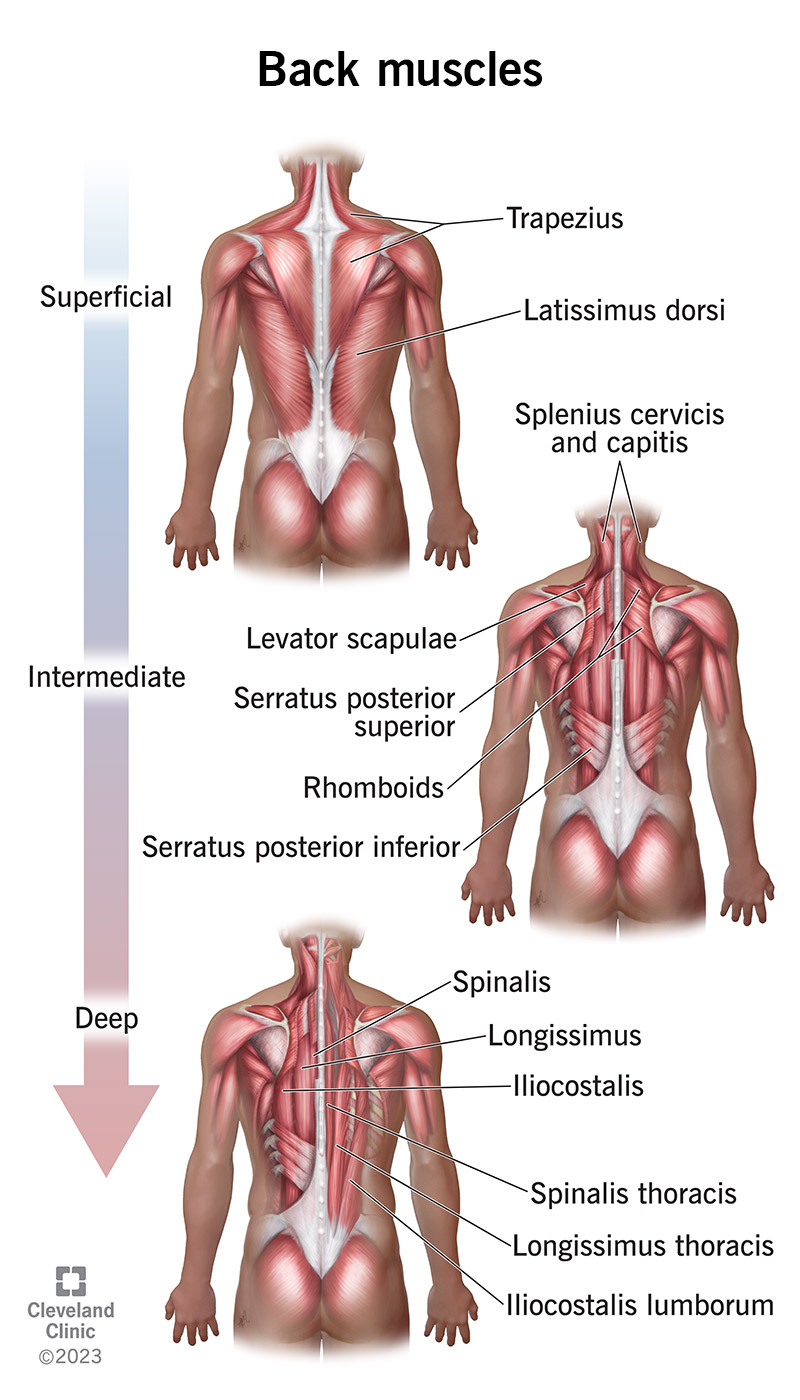Your back muscles help control your posture, let you move and help you breathe. They start at your neck, run down your spine and end just above your hips. Having occasional back pain or stiffness is normal, but visit a provider if you experience pain that lasts more than a week.

Your back has many different muscles. Some support your spine and trunk (your midsection or torso). Others help you stand up, maintain your posture and help you move. Some even help you breathe.
Back muscles are skeletal muscles — they’re part of your musculoskeletal system.
Because your back muscles support so much of your weight and help you perform so many movements, it shouldn’t be a surprise that they’re some of the most commonly injured muscles. Back muscle issues are one of the most common causes of low back pain.
Visit a healthcare provider if you’re experiencing back pain or think you’ve injured your back.
Advertisement
Cleveland Clinic is a non-profit academic medical center. Advertising on our site helps support our mission. We do not endorse non-Cleveland Clinic products or services. Policy
Your back muscles support your body and help you move. They’re the main structural support for your trunk. They keep you stable and help you maintain your posture when you’re moving or sitting still.
Your back muscles work together to reposition your torso. If you choose to change your position, your back muscles move your back and torso. But even if you’re not actively thinking about it, your back muscles are constantly holding you in place. It’s like having a built-in security system for your posture.
Muscles in your back help you move other parts of your body too, including your:
Your back muscles work together to allow you to bend over, twist, turn your head and extend your back. They also help you breathe by expanding and contracting your chest when you breathe in (inhale) and out (exhale). This is an involuntary action — something your body does automatically without you controlling it.
Your back muscles start just under your skull, go across your shoulders and run all the way down your spine to your lower back (just above your hips).
They attach to bones across your body, including your:
Healthcare providers divide your back muscles into three groups or layers:
Superficial back muscles
Superficial back muscles are the ones closest to the surface just under your skin. They help you move your shoulders. They’re usually the ones people think of when picturing their back muscles. Superficial muscles include your:
Intermediate back muscles
The intermediate back muscles are just above and below your ribcage. They help move your ribs, including when you’re breathing. You have two intermediate back muscles:
Intrinsic back muscles
The intrinsic muscles are the deepest layer of back muscles. They’re under the other two layers, closest to your spine. Healthcare providers divide intrinsic back muscles into their own superficial, intermediate and deep subgroups.
Even though they use the same names, they’re still all part of the intrinsic group. The repeated subgroup names reference where they’re located compared to each other. So, for example, your superficial intrinsic muscles are closer to the surface of your skin than your intermediate intrinsic muscles. And your deep intrinsic muscles are underneath all the other groups and subgroups.
Advertisement
Your muscles are made of thousands of small fibers woven together. These fibers stretching and pressing together is what allow your body to move when you squeeze a muscle. Your back muscles weave together like a quilt that covers your back. They run in all directions and work together to move you and your body.
Back strains are the most common back muscle injury. Muscle strains (pulled muscles) happen when you overuse a muscle or lift something incorrectly. The strands of muscle fiber are stretched beyond their limit and tear apart. You’ve seen this happen if you’ve ever tried to use an old bungee cord to hold something in place.
The most common symptoms of a back muscle injury include:
Advertisement
A healthcare provider will suggest treatments depending on which type of injury you have (and its severity), including:
Stretching and warming up before exercise or physical activity are the best ways to prevent muscle injuries. Increasing your overall flexibility will also protect your muscles from injuries. The more flexible you are, the more room your muscle fibers have to stretch before they begin to tear.
Increase your activity level gradually. Don’t suddenly ramp up your training intensity or start exercising way more often than you usually do.
Visit a healthcare provider if you’re experiencing back pain that doesn’t get better in a week with rest and other at-home treatments. Go to the emergency room if you have any of the following symptoms:
If you have back pain that doesn’t get better with pain relievers and rest, call a healthcare provider. Get help right away if you have:
Your back muscles are a complex network that helps you do everything from lifting a heavy box to staying comfortable when you’re glued to the couch watching a movie. No matter what you’re doing, you’re using your back muscles (especially because they help you breathe).
If something’s causing you back pain, don’t ignore it. It’s common to have minor aches or stiffness, but visit a provider if you have back pain that lasts for more than a week. Being in pain doesn’t have to be a part of your daily routine.
Last reviewed on 07/07/2024.
Learn more about our editorial process.
Advertisement
Cleveland Clinic is a non-profit academic medical center. Advertising on our site helps support our mission. We do not endorse non-Cleveland Clinic products or services. Policy